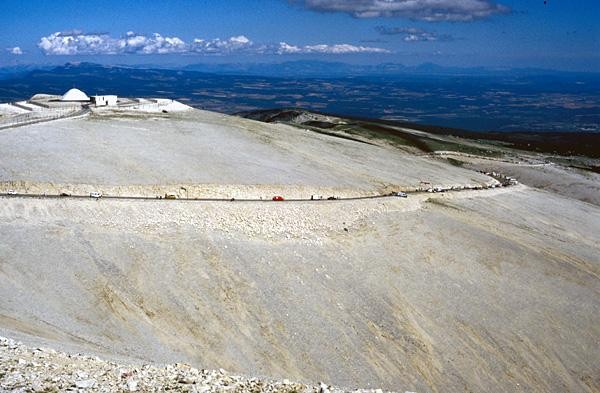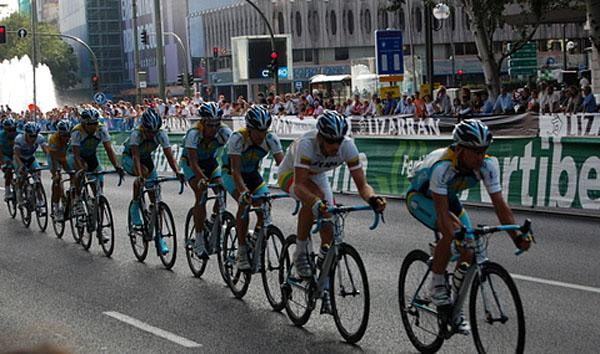Slow fuse ignites Prudhomme's third Tour
Mont Ventoux in the Tour The Giant of Provence has been a part of the Tour de France in 13 separate...


Tour de France feature, October 29, 2008
The recently announced 2009 Tour de France route gives interest from start to finish, and should be free of any lull in the action from Monaco to Paris. Procycling's editor Peter Cossins compares the parcours to another Grand Tour, and thinks it will have a slow fuse which will ignite the fireworks on the penultimate stage.
The 2009 Tour de France is only the third that Christian Prudhomme has devised since taking over from Jean-Marie Leblanc as race director in 2006, but during that short period Prudhomme has quickly established a reputation for innovation that has helped reinvigorate a race that had become all too predictable in its presentation.
Having previously done away with the team time trial and, last year, the prologue, next year's offers yet more changes - or at least it does to those not overly familiar with the sadistic nature of the route of most editions of the Giro d'Italia.
While it's far from unusual for the Tour to have a number of its key stages during its final week, it is almost unheard of for the Grande Boucle to have the sting in its tail that Prudhomme announced in Paris's Palais des Congrès last week. The rumours of the return of the Ventoux to the Tour after an absence of seven years were widespread, but no one had an inkling about how it was going to be served up; the odds would have been extreme on it appearing as the race's final summit finish on the penultimate day of the race.
Putting aside the dismay of the media already contemplating an all-nighter on the A6 autoroute between Provence and the Tour's final flourish in Paris, Prudhomme has delivered a route that will hopefully keep the final result in doubt until the race reaches that spectacularly exposed weather station atop "The Giant of Provence". Perhaps he'd been taking tips from Giro boss Angelo Zomegnan.
Tips from Zomegnan?
Get The Leadout Newsletter
The latest race content, interviews, features, reviews and expert buying guides, direct to your inbox!
Ever the innovator - sometimes to the point of ridiculousness - Zomegnan has little compunction about sandwiching some of the toughest days of his major tour into the latter half of its final week. Prudhomme has now done the same - and it's all the more impressive an achievement given Paris's distance from a mountain of any kind, let alone the Ventoux.
Determined that his races will rarely be afflicted by the regular lulls that were a feature of Tours during the Leblanc years, Prudhomme has cleverly set the likely contenders for the yellow jersey regular examinations of form. Rather than building steadily towards the frightening challenge offered by the Ventoux, the 2009 route asks tough questions throughout.
We've seen long time trials on the opening day before, but not as tough as the 15km test in and around Monaco. There are tough climbs right behind the principality, and stage one sends the riders a good way up them on a very technical course that will favour daredevils rather than specialists. Think Samuel Sánchez rather than Fabian Cancellara.
A couple of days on, Prudhomme has re-introduced the team time trial; it's not anywhere near as long as the 50km+ epics of the Leblanc era, but once again more in line with what Zomegnan tends to serve up at the Giro. The TTT's reappearance partly explains Garmin's signing of Bradley Wiggins to boost their already impressive group of testers. It also sharpens the focus on what most experts believe will be an especially key ingredient for overall contenders: the need for a strong team from beginning to last.
The fear of Astana's domination
One fear that will be nagging Prudhomme and, I would imagine, many team managers is the possibility of Astana dominating the race completely from this point on, especially if Lance Armstrong and Johan Bruyneel are in tandem next July. Nine months out, they already look like they'd be too strong for the CSC team that ruled this year's Tour but has since been upset by the departure of Carlos Sastre and the hit taken by Frank Schleck's belated link to Puerto suspect Eufemiano Fuentes. The TTT just could bring the first appearance of a Kazakh-flavoured steamroller.
But even Astana might struggle with what is another factor a Grand Départ in the south could bring: la canicule - oppressive heat. Most years the Tour's transitional stages across the Midi between the Alps and the Pyrenees are the hottest of the race, and can be of inferno-like intensity. For riders already weakened by many days in the saddle, heat of this nature can rapidly lead to stomach problems, increased fatigue and, for many, a premature end to the race.
Clearly, starting in the south should mean the Tour peloton won't be affected as badly as usual by the heat, given fresh legs and fully charged batteries. However, the Tour peloton is always extremely nervous during the first week of the race and the strong winds that buffet the Midi will increase the tension.
Think back to 2007 when Christophe Moreau lost his Tour hopes on a pretty nondescript stage between Marseille and Montpellier after he crashed and was then stymied by strong cross-winds. The roads towards Perpignan are particularly tricky in this respect, and the strongest teams will be determined to make sure their protected riders are kept up near the front of the race. As half the teams in the race will be battling to do this, the first week into Spain is likely to see some contenders dumped out of the contention before the Pyrénées have even been reached.
Will the Alsace bring more danger than the high mountains?
2009's Pyrénéan stages look more likely to give a gentle shake-up of the GC rather than a complete makeover. The stage to Arcalis is both the longest of the race and the first summit finish - but the next two days end well out of the high mountains. Prudhomme clearly doesn't want the yellow jersey decided this early.
More intriguing is the stage across the Vosges to Colmar. Unlike Italy, France doesn't offer the same range of opportunities for moyenne montagne stages such as these. T-Mobile isolated Lance Armstrong in 2005 on a similar medium mountain stage, causing genuine alarm as all of his Discovery Channel team was dropped on the finale.
And then to the Alps... Unlike this year's Tour which featured the mighty Agnel, Lombarde, Bonnette and Galibier en route to what turned out to be the decisive moments on Alpe d'Huez, next year's three days in the Alps appear much more benign. Prudhomme and his organisational team are clearly intending to raise the temperature gradually until full burn is reached somewhere on the way up the Ventoux on that final Saturday.
The consensus is that this is a route which favours pure climbers, but I'm not totally convinced. Prudhomme has given most of the likely contenders reasons to be cheerful. This probably won't mean the winner will come from outside a small group comprised of Alberto Contador, Cadel Evans, Andy Schleck and Armstrong. However, Alejandro Valverde for one will be looking at this route and probably thinking it offers his best chance of a Tour victory. If he's in contention coming away from Andorra, Valverde may just end up keeping Spain's winning run going at the Tour for a fourth year.
For more great in-depth features and interviews, subscribe to Procycling and find out more details about a free two-hour DVD featuring the best stages of the last 20 years of the Tour de France!